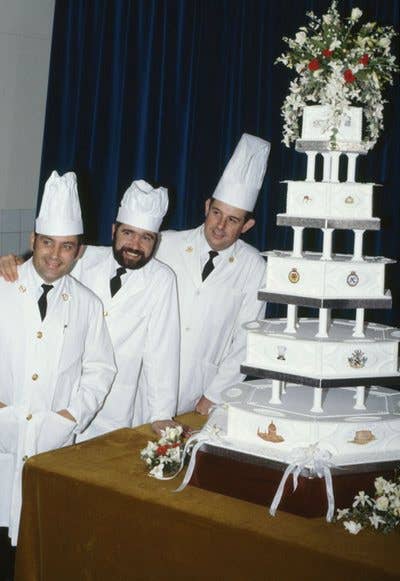
Fruitcakes Piled High: A Brief History of Royal Wedding Cakes
When I tune in early tomorrow morning to experience the frills and glamour of the British royal wedding, I expect to see layers of white, silky material, rows of pearls, and royal insignias — and I don't mean on Kate Middleton's wedding dress. Instead, I'm watching for the wedding cake, which, according to official wedding confectioner Fiona Cairns, will be a multi-tiered, fondant-frosted fruitcake. Love or hate that pick, come Friday, the cake will take its place a long and intricate tradition of royal confectionery.
Following the historical trail of modern royal wedding cakes took me back to the Victorian era, during which wedding cakes rapidly evolved from single-layered, leaden affairs to the delicate, multi-tiered centerpieces that we see today. Queen Victoria's wedding cake, served in celebration of her marriage to Prince Albert in 1840, was a 14-inch-deep, one-layer plum cake. But a short eleven years later, the first three-tiered wedding cake made its debut at London's Crystal Palace Exhibition. Even though only the first tier of this wedding cake was made of cake — the top sections were pure sugar — the notion of a tall cake with progressively smaller tiers had sticking power; it changed wedding cake fashion forever.
After the multi-tiered cake model caught on in stylish circles, royals demanded increasingly larger and more elaborate cakes for their weddings. When Queen Victoria's oldest daughter married Prince Frederick William of Prussia in 1858, she served a triple-layer cake that stood between six and seven feet tall, adorned with jasmine, orange blossoms, silver leaves, the bride and groom's royal arms, and several rows of pearls. King George V's wedding cake, from 1893, was even more impressive: its four tiers were separated by columns and statues that lent the cake extra height.
The royal fondness for outrageously large wedding cakes continued to the end of the 20th century, though the decor took a turn for the austere. For her wedding in 1923, the Queen Mother chose a 10-foot, 800-pound wedding cake with baroque ornamentation symbolizing love and peace; but by 1981, when Lady Diana Spencer married Prince Charles, cakes with clean lines and sparse adornment were much more in vogue. The stylish princess had only a sugared overlay of the royal coat of arms to adorn her five-layer cake that year.
Thanks to royal reticence and tight-lipped bakers, the makeup of many cake behind the frosting has remained something of a mystery. In 1840 the Observer described Queen Victoria's wedding cake in vague — if florid — terms as "consisting of the most exquisite compounds of all the rich things with which the most expensive cakes can be composed, mingled, and mixed together in delightful harmony by the most elaborate science of the confectioner." More than a century and a half later, for Princess Diana's wedding, not that much had changed. The celebrated Belgian baker S.G. Sender kept the exact recipe for the official wedding cake a secret, though we know that Diana celebrated over fruitcake. (A slice of it sold for $1,830 at a 2008 auction.)
Middleton and Prince William have been heralded as the royal couple that will bring the British monarchy into the 21st century, so the burden falls on them to bring the wedding cake tradition into contemporary times as well. Middleton has reportedly brainstormed with Cairns using mood boards to incorporate all the ideas and history that she wants the cake to represent. While Cairns will tweak her classic recipe to include environmentally conscious ingredients like free-range eggs and organic flour, Middleton's choice of fruitcake is a clear nod to Diana's wedding. Talk of the cake's old-school decoration, including intricate piping and scrollwork, is a nod to an even more distant history, a cenuries-old tradition of which Middleton will now be an inextricable part.
Keep Reading
Continue to Next Story










